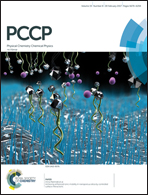Cesium lead iodide solar cells controlled by annealing temperature†
Abstract
An inorganic lead halide perovskite film, CsPbI3, used as an absorber in perovskite solar cells (PSCs) was optimized by controlling the annealing temperature and the layer thickness. The CsPbI3 layer was synthesized by one-step coating of CsI mixed with PbI2 and a HI additive in N,N-dimethylformamide. The annealing temperature of the CsPbI3 film was varied from 80 to 120 °C for different durations and the thickness was controlled by changing the spin-coating rpm. After annealing the CsPbI3 layer at 100 °C under dark conditions for 10 min, a black phase of CsPbI3 was formed and the band gap was 1.69 eV. Most of the yellow spots disappeared, the surface coverage was almost 100%, and the rms roughness was minimized to 3.03 nm after annealing at 100 °C. The power conversion efficiency (PCE) of the CsPbI3 based PSC annealed at 100 °C was 4.88%. This high PCE value is attributed to the low yellow phase ratio, high surface coverage, low rms roughness, lower charge transport resistance, and lower charge accumulation. The loss ratio of the PCE of the CH3NH3PbIxCl3−x and CsPbI3 based PSCs after keeping in air was 47 and 26%, respectively, indicating that the stability of the CsPbI3 based PSC is better than that of the CH3NH3PbIxCl3−x based PSC. From these results, it is evident that CsPbI3 is a potential candidate for solar cell applications.



 Please wait while we load your content...
Please wait while we load your content...